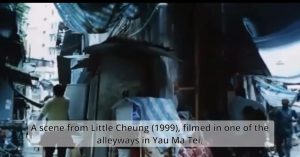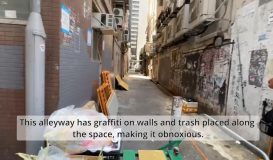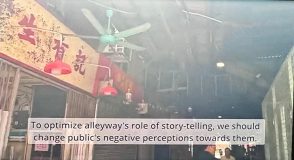Video Essay Link: https://youtu.be/vPZPaXcfnyU
Introduction
Set in the alleyways in Yau Ma Tei, the video essay named “The Demolition Casualty in the City: Alleyways, Yau Ma Tei” argues that alleyways are greatly harmed by redevelopment. The theme demolition casualty implies their irresistibility and vulnerability yet possessing an optimistic view on the preservation of passageway by the help from community members. Secondary sources will mainly be used to support the hypothesis, coupling with on-site video clips and photographs featuring buildings, alleyways that provide an understanding of the current situation in the area. In the following sections, I will probe into specific featured scenes to expand on the methodology used, including camera angles technique, evidence from academic sources and include suggestions that can slow down the rate of the space’s demolition. Alleyways are powerful storytellers of Hong Kong, while the choice targeting Yau Ma Tei is largely influenced by the movie Little Cheung (1999).
Alleyways’ Features
Caroline Wutrich, a Swiss architect based in Hong Kong, said that “In order to understand Hong Kong, follow its vast network of “in-between” spaces”. Lane-way spaces offer an authentic and fresh narrative from the perspective of marginalized groups . It deviates from presenting alluring images of Hong Kong, In fact, the dilemma of alleyways as an undesirable urban spaces hindering modernization are conceptualized as “fields of forces” by Marie Gibert-Flutre, embodying the contradictory global and local forces at work in the process of urbanization, reinforcing local identity.
There is a diminishing function of alleyways in Hong Kong. For instance, the residential function can be seen with 85% of Ho Chi Minh City citizens still living in alleyways, an architectural function of setting historical buildings apart in Beijing . Yet in Hong Kong, even though corridor and alleyways are great mediums to engage the community due to its complex assembly, informed and organic components, some might only be confined to dish washing areas for restaurant, or some solely serves as aesthetic symbol for certain well-maintained alleyways , like walls murals in Tai Ping Shan Street with Graffiti paints on walls. However, most of the passageways possess low hygiene.
Methodology

The video starts with extracting a scene filming both protagonists being scolded by their parents in one of the alleyways located in Yau Ma Tei in Little Cheung (1999), providing viewers with a general idea of the direction of video.

The main subject is introduced in 0:25 of the video. It then zoom in to the objects to show the function of alleyway.

Another alleyway is introduced in 1:45 of the video to emphasize the homogeneity of alleyways’ role.

Another alleyway near the fruit market is filmed while presenting its functions since the alleyway is more well-maintained than others, providing a possible way to increase the public’s positive perception towards the lane-way.
Ways to reduce casualty of alleyway
By incorporating alleyways with consumerism elements, e.g. coffee shop, gym, pocket parks, it increases the sense of safety of residents.
Alleyway’s nature of being free from traffic should also be maintained since people can engage in social activities like chatting and eating in serenity.
In addition, there can be an expansion of revitalization projects initiated from non-governmental organizations. For example, in 2013, ‘Magic Lens’ was a pilot project initiated by activists in Caritas Hong Kong, involving activities to raise awareness of neglected public spaces in Hong Kong. Local secondary students serve as city ambassadors to interact with local residents and shopkeepers understanding more on the alleyways’ transformation, or they serve as interns to work on a grant proposal to the Urban Renewal Fund for the projects. Some cohorts from the Chinese University of Hong Kong also built street furniture for a community event, which invites some cappella performers and include food and games to encourage old and new residents to socialize.
Conclusion
The fading of lane-ways are partly aligned with Rob Nixon’s concept of slow violence, meaning violence with postponed effect and the environmentalism of the poor, meaning that the marginalized population is disproportionately affected by environmental transformations. With the scenes of alleyways being harmed, it holds good prospects on the future development of these spaces as contributors to Hong Kong’s cultural representations.
Bibliography
Audin, J., Gibert-Flute, M. & Imai, H., (2020). Asian Alleyways: An Urban Vernacular in Times of Globalization.Street-corner society and everyday politics in the Beijing hutong Ethnographic perspectives. pp. 57-86. https://doi.org/10.2307/j.ctv1b0fvwq.6
Borio, G. & Wuthrich, C. (2015). Hong Kong in-between. Verlag Scheidegger & Spiess AG Park Books.
Cookson, P. (2011). Dimensions of Density in Hong Kong. Council on Tall Buildings and Urban Habitat Journal 11, 34-39 https://www.jstor.org/stable/24193149
Cummins, A., Parkes, D. (2017. May 18). Hong Kong’s coolest hidden alleyways. Time Out. Coolest hidden alleyways in Hong Kong (timeout.com)
Fruit Chan. Little Cheung (1999)
Gibert-Flute, M. & Imai, H. (2020). Asian Alleyways: An Urban Vernacular in Times of Globalization. Between ‘network’ and ‘territory’ Ho Chi Minh City’s alleyways as challenged liminal spaces. Amsterdam University Press. pp. 33-56.https://doi-org.eproxy.lib.hku.hk/10.2307/j.ctv1b0fvwq.5
Gibert-Flute, M., Imai, H. (2020). Asian Alleyways: An Urban Vernacular in Times of Globalization. Magic Lanes A placemaking approach for laneway spaces in Hong Kong. pp. 181-210. j.ctv1b0fvwq.11.pdf (hku.hk)
Gibert-Flute, M. (2018). Rethinking metropolitan production from its underside: A view from the alleyways of Ho Chi Minh City. Sage, 50(3), 589-607, https://doi-org.eproxy.lib.hku.hk/10.1177/0308518X17751230
HKU Architecture. Revitalizing alleys in high-density cities: How urban and landscape design interventions impact the sense of safety | HKU Faculty of Architecture
Huang, M. (2021). Revisiting Hong Kong: Fruit Chan’s ‘Little Cheung’. In Gregory Bracken (Ed.), Aspects of Urbanization in China (101-116). Amsterdam University Press
Nixon, R. (2011). Slow Violence and the Environmentalism of the Poor. Harvard University Press.
Poon, L. (2016. July 16). The Roots of Hong Kong’s Identity Are in Its Back Alleys. Bloomberg. Two Architects Explore the Microeconomy of Hong Kong’s Alleyways – Bloomberg
News Pictures in the video:
Flower Market renewal plans unveiled, (2024). Flower Market renewal plans unveiled – RTHK
Policy Address 2023, (2023). (Policy Address 2023) Mong Kok East and Yau Ma Tei South to be redeveloped in the coming five years | The Standard
Name: Kan Nok Ming Valerie
UID: 3036233483